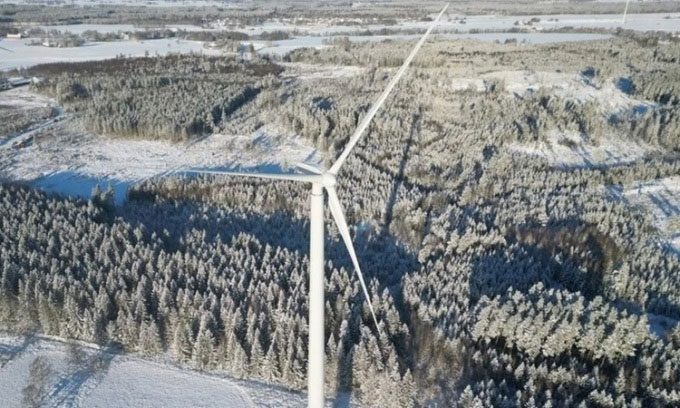Modvion, the Swedish startup building the world’s tallest wooden wind turbine, is utilizing wood to harness wind energy with significant potential for the future.
The completely new turbine from Modvion is installed near Gothenburg and stands 150 meters tall from the base to the tip of the highest blade. The 2-megawatt generator located at the top of the turbine tower has begun supplying electricity to Sweden’s power grid, enough to meet the needs of approximately 400 households. Otto Lundman, the company’s CEO, hopes to further increase the height of the wooden turbine, BBC reported on December 28.

Modvion’s wooden turbine has a capacity of 2 megawatts. (Photo: Modvion).
On the horizon near Modvion’s project, several similarly shaped turbines are spinning. Unlike wood, their primary material is steel, similar to most turbine towers around the world. Strong and durable, steel enables the construction of gigantic turbines and wind farms that can be located both on land and offshore. However, steel still has limitations, especially for onshore projects.
With the increasing demand for taller turbines that capture stronger winds with larger generators, the diameter of the cylindrical steel towers supporting the structure also needs to increase. With many road tunnels, bridges, and roundabouts in the way, many operators share that transporting these massive metal blocks to the turbine installation sites has become a headache, while also limiting the height of steel turbines.
From the outside, Modvion’s wooden turbine and the steel version show hardly any visible differences. Both have a thick white coating for protection, with blades primarily made of fiberglass attached to the generator, producing electricity as the turbine blades rotate. Only when examining from inside the turbine tower do the differences become apparent. The tower walls are covered with raw wood. Lundman stated that the major advantage of this turbine model is that by using wood and resin, the turbine tower can be constructed in smaller, more transportable modules. This makes building taller turbine towers easier and allows them to be transported to challenging locations.
However, Dr. Maximilian Schnippering, the sustainability director at Siemens Gamesa, one of the largest turbine manufacturers in the world, noted that more components require more trucks, labor, and time for installation. Schnippering sees the modular system as an advantage and believes that wooden turbine towers can support steel structures. While steel can be used for modular design, assembling the components would increase costs and maintenance efforts.
Modvion’s turbine tower uses approximately 200 trees. Modvion has indicated that they hope to soon build a taller turbine and establish a facility to produce 100 modular wooden turbines per year by 2027.





















































